2008 MERCEDES-BENZ SL ROADSTER child seat
[x] Cancel search: child seatPage 54 of 317
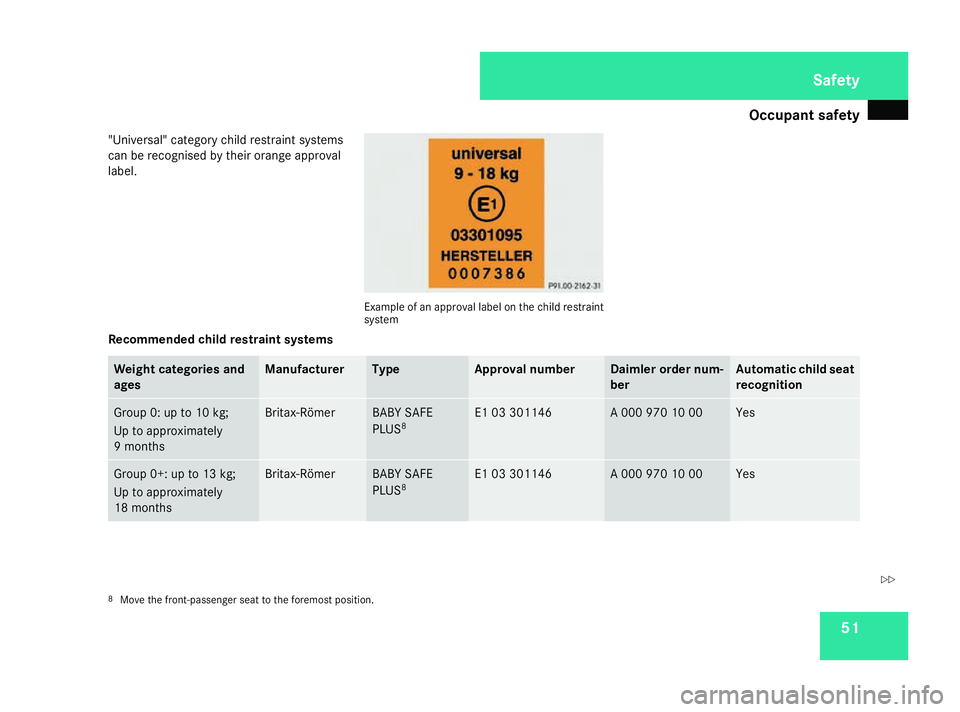
Occupant safety
51
"Universal" category child restraint systems
can be recognised by their orange approval
label. Example of an approval label on the child restraint
system
Recommended child restraint systems Weight categories and
ages Manufacturer Type Approval number Daimler order num-
ber Automatic child seat
recognition
Group 0: up to 10 kg;
Up to approximately
9m
onths Britax-Römer BABYS
AFE
PLUS 8 E1 03 301146 A0
00 970 10 00 Yes
Group 0+: up to 13 kg;
Up to approximately
18 months Britax-Römer BABYS
AFE
PLUS 8 E1 03 301146 A0
00 970 10 00 Yes
8
Move the front-passenger seat to the foremost position. Safety
230_AKB; 5; 4, en-GB
bjanott ,V ersion: 2.9.6
2008-04-08T15:09:54+02:00
-Seite 51 ZDateiname: 6515_3089_02_buchblock.pdf; preflight
Page 55 of 317
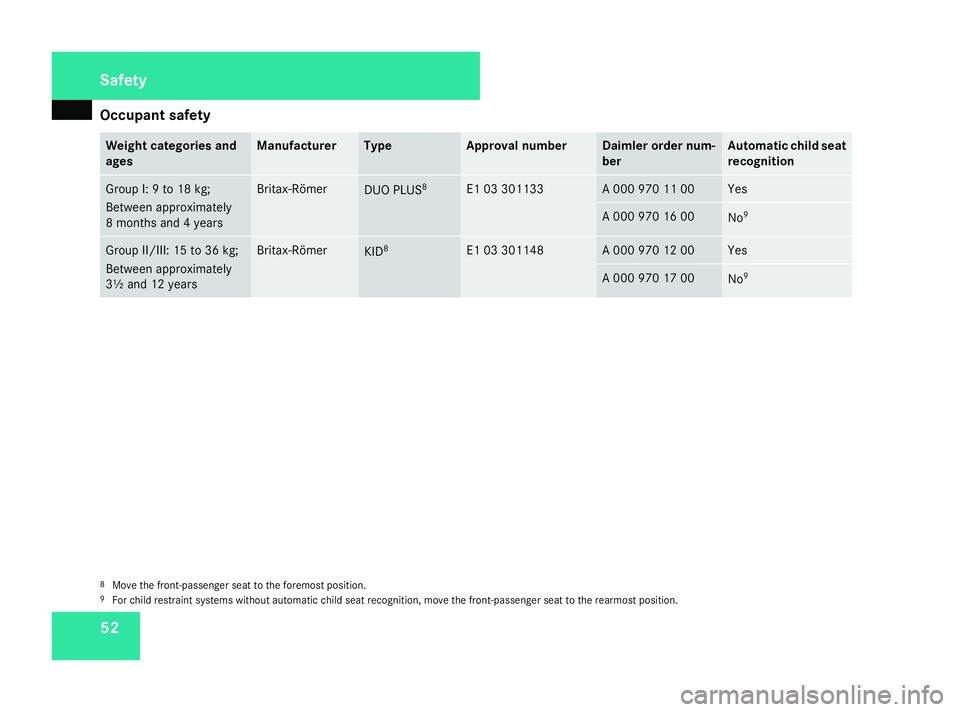
Occupant safety
52 Weight categories and
ages Manufacturer Type Approval number Daimler order num-
ber Automatic child seat
recognition
Group I:
9to18k g;
Between approximately
8m onths and 4years Britax-Römer
DUO PLUS
8 E1 03 301133 A0
00 970 11 00 Yes
A0
00 970 16 00 No
9 Group II/III: 15 to 36 kg;
Between approximately
3½ and 12 years Britax-Römer
KID
8 E1 03 301148 A0
00 970 12 00 Yes
A0
00 970 17 00 No
9 8
Move the front-passenger seat to the foremost position.
9 For child restraint systems without automatic child seat recognition, move the front-passenger seat to the rearmost position. Safety
230_AKB
;5;4,en-GB
bjanott, Version:2.9.6
2008-04-08T15:09:54+02:0
0-Seite 52 Dateiname: 6515_3089_02_buchblock.pdf; preflight
Page 77 of 317

Seats
74 Seats
Points to remember
G
Risk of injury
The seats can still be adjusted when there
is no key in the ignition lock. For this rea-
son, children should never be left unsuper-
vised in the vehicle. They could become
trapped when adjusting aseat. G
Risk of accident
Only adjust the driver's seat when the vehi-
cle is stationary. You will otherwise be dis-
tracted from the road and traffic conditions
and you could lose control of the vehicle as
ar esult of the seat moving. This could
cause an accident. G
Risk of injury
Make sure that nobody can become trap-
ped when you adjust the seat.
Observe the notes concerning the airbag
system.
Secure children as recommended; see
"Children in the vehicle" section.
! When you move the seats, make sure that
there are no objectsint he footwell orbehind the seats. Otherwise, you could
damage the seats and the objects.
i The head restraint scannot be removed. Adjusting the seat electrically
1
Head restraint height
2 Seat height
3 Seat cushion angle
4 Seat cushion length
5 Seat fore-and-aft adjustment
6 Backrest angle
i You can store the seat settings using the
memory function (Y page 82). Seat fore-and-aft adjustment X
Slide the button forwards or back in the
direction of arrow 5.
Backrest angle X
Slide the button forwards or back in the
direction of arrow 6.
Seat height X
Slide the button up or down in direction of
arrow 2.
Seat cushiona ngle Adjust the angle so that yourt
highs are gently
supported.
X Slide the button up or down in direction of
arrow 3.
Seat cushionl ength X
Slide the button forwards or back in the
direction of arrow 4. Controls
230_AKB; 5; 4, en-GB
bjanott,
Version: 2.9.6
2008-04-08T15:09:54+02:00
-Seite 74 Dateiname: 6515_3089_02_buchblock.pdf; preflight
Page 81 of 317
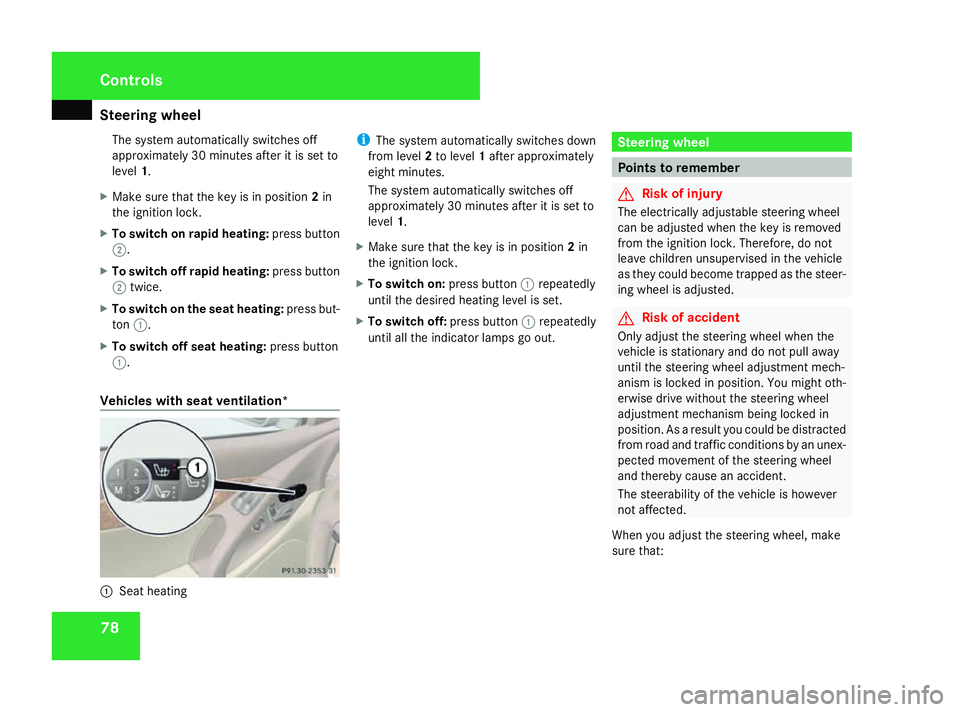
Steering wheel
78The system automatically switches off
approximately 30 minutes after it is set to
level 1.
X Make sure that the key is in position 2in
the ignition lock.
X To switch on rapid heating: press button
2.
X To switch off rapid heating: press button
2 twice.
X To switch on the seat heating: press but-
ton 1.
X To switch off seat heating: press button
1.
Vehicles with seat ventilation* 1
Seat heating i
The system automatically switches down
from level 2to level 1after approximately
eight minutes.
The system automatically switches off
approximately 30 minutes after it is set to
level 1.
X Make sure that the key is in position 2in
the ignition lock.
X To switch on: press button1repeatedly
until the desired heating level is set.
X To switch off: press button1repeatedly
until all the indicator lamps go out. Steering wheel
Points to remember
G
Risk of injury
The electrically adjustable steering wheel
can be adjusted when the key is removed
from the ignition lock. Therefore, do not
leave children unsupervised in the vehicle
as they could become trapped as the steer-
ing wheel is adjusted. G
Risk of accident
Only adjust the steering wheel when the
vehicle is stationary and do not pull away
until the steering wheel adjustment mech-
anism is locked in position. You might oth-
erwise drive without the steering wheel
adjustment mechanism being locked in
position. As aresult you could be distracted
from road and traffic conditions by an unex-
pected movement of the steering wheel
and thereby cause an accident.
The steerability of the vehicle is however
not affected.
When you adjust the steering wheel, make
sure that: Controls
230_AKB; 5; 4, en-GB
bjanott
,V ersion: 2.9.6
2008-04-08T15:09:54+02:00
-Seite 78 Dateiname: 6515_3089_02_buchblock.pdf; preflight
Page 85 of 317

Memory functions
82
X
Make sure that the vehicle is stationary and
that the key is in position 2in the ignition
lock.
X Press button 2for the exterior mirror on
the front-passenger side.
X Use adjustment button 3to adjust the
exterior mirror to aposition which allows
you to see the rear wheel and the kerb.
X Press memory button M(Y pag e82)on
the door control panel.
X Press one of the arrow sonadjustment but-
ton 3withi nthree seconds.
The parking position is stored if the exterior
mirror does not move.
i If the mirror moves out of position, repeat
the steps. You can adjust the exterior mir-
ror again after storing the setting.
Calling up astored parking position set-
ting X
With the key in position 2in the ignition
lock and with exterior mirror on the front-
passenger side 2activated, engage
reverse gear.
Exterior mirror on the front-passenger 2
moves to the stored parking position. The exterior mirror on the front-passenger
side moves back to its original position:
R as soon as you exceed aspee dof
10 km/h
R about ten seconds after you have disen-
gaged reverse gear
R if you press button 1for the exterior mir-
ror on the driver's side Memory functions
Storing settings
You can store up to three different settings
using the memory button.
The following settings are stored as asingle
memory preset:
R position of the seat, backres tand head
restraint
R multi-contour seat*: the backres tside
cushions of the sea tcushion and the back-
rest, contour of the backres tinthe lumbar
and shoulde rregions
R driver's side :steering-whee lposition
R driver's side :position of the exterior mir-
rors on the driver's and front-passenger
sides G
Risk of injury
The memory function can be use dwhent he
key has been removed .For this reason,
children should never be left unsupervised
in the vehicle. They coul dotherwise
become trappe dwhenm oving the sea tor
the steering wheel. Controls
*optional
230_AKB; 5; 4, en-GB
bjanott,
Version: 2.9.6 2008-04-08T15:09:54+02:00-Seite 82 Dateiname: 6515_3089_02_buchblock.pdf; preflight
Page 87 of 317
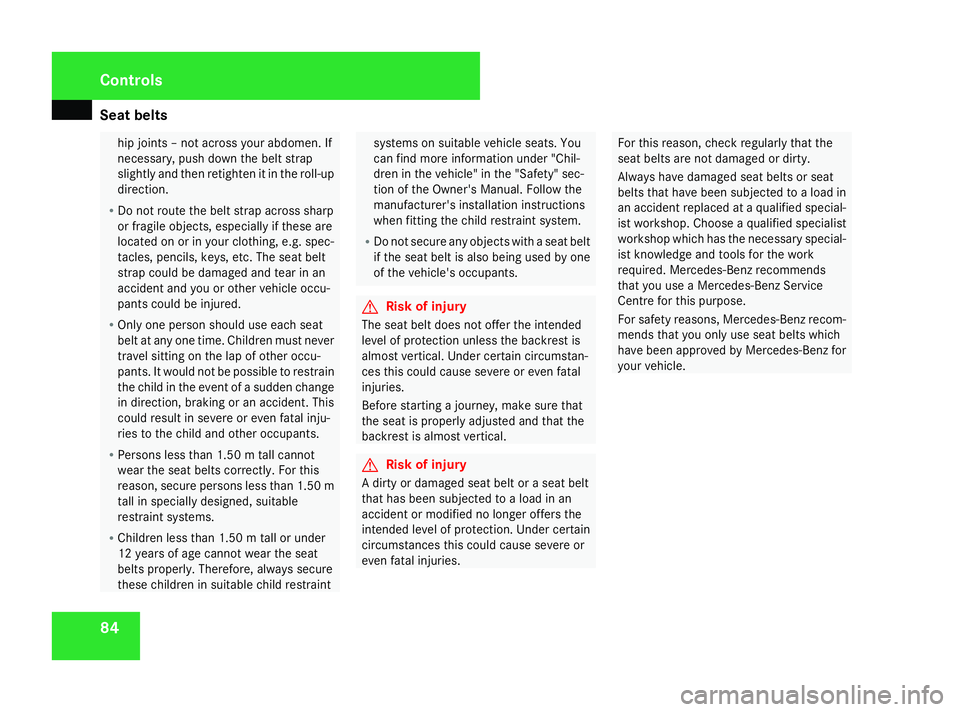
Seat belts
84 hip joints–n
ot across your abdomen. If
necessary, push down the belt strap
slightly and then retighten it in the roll-up
direction.
R Do not route the belt strap across sharp
or fragile objects, especially if these are
located on or in your clothing, e.g. spec-
tacles, pencils, keys, etc. The seat belt
strap could be damaged and tear in an
accident and you or other vehicle occu-
pants could be injured.
R Only one person should use each seat
belt at any one time. Children must never
travel sittingont he lap of other occu-
pants. It would not be possible to restrain
the child in the event of asudden change
in direction, braking or an accident. This
could result in severe or even fatal inju-
ries to the child and other occupants.
R Persons less than 1.50 mtall cannot
wear the seat belts correctly. For this
reason, secure persons less than 1.50 m
tall in specially designed, suitable
restraint systems.
R Children less than 1.50 mtall or under
12 years of age cannot wear the seat
belts properly. Therefore, always secure
these children in suitable child restraint systems on suitable vehicle seats. You
can find more information under "Chil-
dren in the vehicle" in the "Safety" sec-
tion of the Owner's Manual. Follow the
manufacturer's installation instructions
when fitting the child restraint system.
R Do not secure any objectsw ithaseat belt
if the seat belt is also being used by one
of the vehicle's occupants. G
Risk of injury
The seat belt does not offer the intended
level of protection unless the backrest is
almost vertical. Under certain circumstan-
ces this could cause severe or even fatal
injuries.
Before startingaj ourney, make sure that
the seat is properly adjusted and that the
backrest is almost vertical. G
Risk of injury
Ad irty or damaged seat belt or aseat belt
that has been subjected to aload in an
accident or modified no longer offers the
intended level of protection. Under certain
circumstances this could cause severe or
even fatal injuries. For this reason, check regularly that the
seat belts are not damaged or dirty.
Always have damaged seat belts or seat
belts that have been subjected to
aload in
an accident replaced at aqualified special-
ist workshop. Choose aqualified specialist
workshop which has the necessary special-
ist knowledge and tools for the work
required. Mercedes-Benz recommends
that you use aMercedes-Benz Service
Centre for this purpose.
For safety reasons, Mercedes-Benz recom-
mends that you only use seat belts which
have been approved by Mercedes-Benz for
your vehicle. Controls
230_AKB; 5; 4, en-GB
bjanott
,V ersion: 2.9.6
2008-04-08T15:09:54+02:00
-Seite 84 Dateiname: 6515_3089_02_buchblock.pdf; preflight
Page 234 of 317
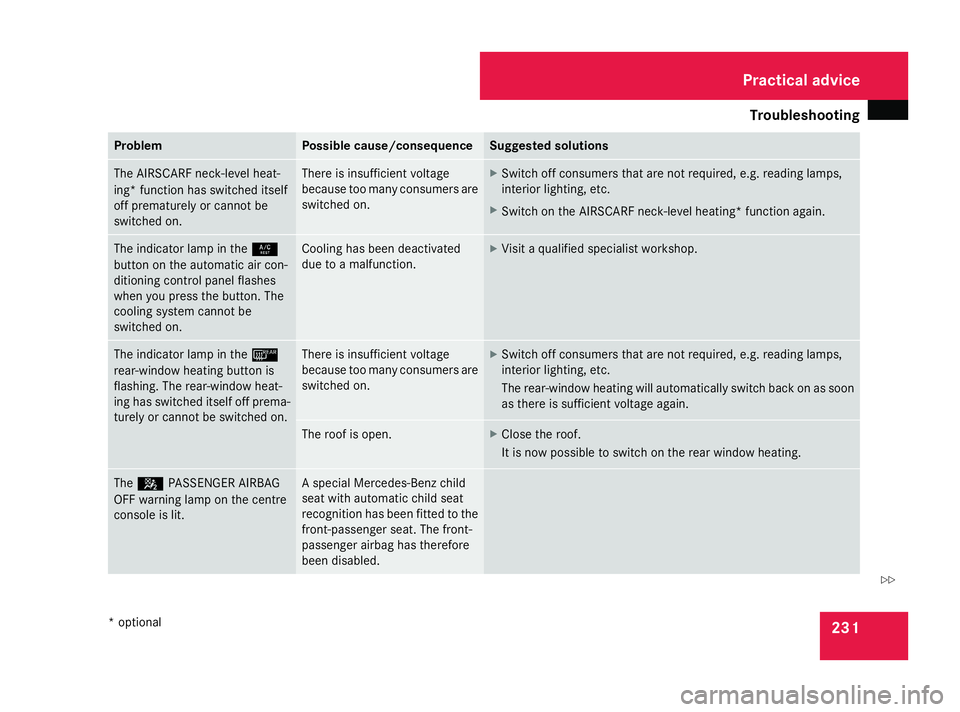
Troubleshooting
231Problem Possible cause/consequence Suggeste
dsolutions Th
eA IRSCARF neck-leve lheat-
ing *functio nhasswitched itself
off prematurel yorcannot be
switched on. There is insufficient voltage
because too many consumers are
switched on. X
Switch off consumers tha tare not required ,e.g.r eading lamps,
interior lighting ,etc.
X Switch on the AIRSCARF neck-leve lheating* functio nagain. Th
eindicator lamp in the 9
button on the automatic ai rcon-
ditioning control panel flashes
when yo upress the button. The
cooling syste mcannot be
switched on. Cooling ha
sbeend eact ivated
du etoam alfunction. X
Visi taq ualified specialis tworkshop. Th
eindicator lamp in the ¯
rear-window heating button is
flashing. Th erear-window heat-
ing ha sswitched itsel foff prema-
turel yorc annot be switched on. There is insufficient voltage
because too many consumers are
switched on. X
Switch off consumers tha tare not required ,e.g.r eading lamps,
interior lighting ,etc.
Th er ear-window heating will automaticall yswitch back on as soon
as there is sufficient voltag eagain. Th
er oofiso pen. X
Clos ethe roof.
It is now possibl etoswitch on the rea rwindo wh eating. The
5 PASSENGER AIRBAG
OFF warning lamp on the centre
consol eislit. As
pecial Mercedes-Benz child
seat with automatic child seat
recognition ha sbeenf itted to the
front-passenge rseat. Th efront-
passenge rairba gh astherefore
been disabled. Practical advice
*o ptional
230_AKB; 5; 4, en-GB
bjanott,
Version: 2.9.6 2008-04-08T15:09:54+02:00-Seite 231 ZDateiname: 6515_3089_02_buchblock.pdf; preflight
Page 235 of 317
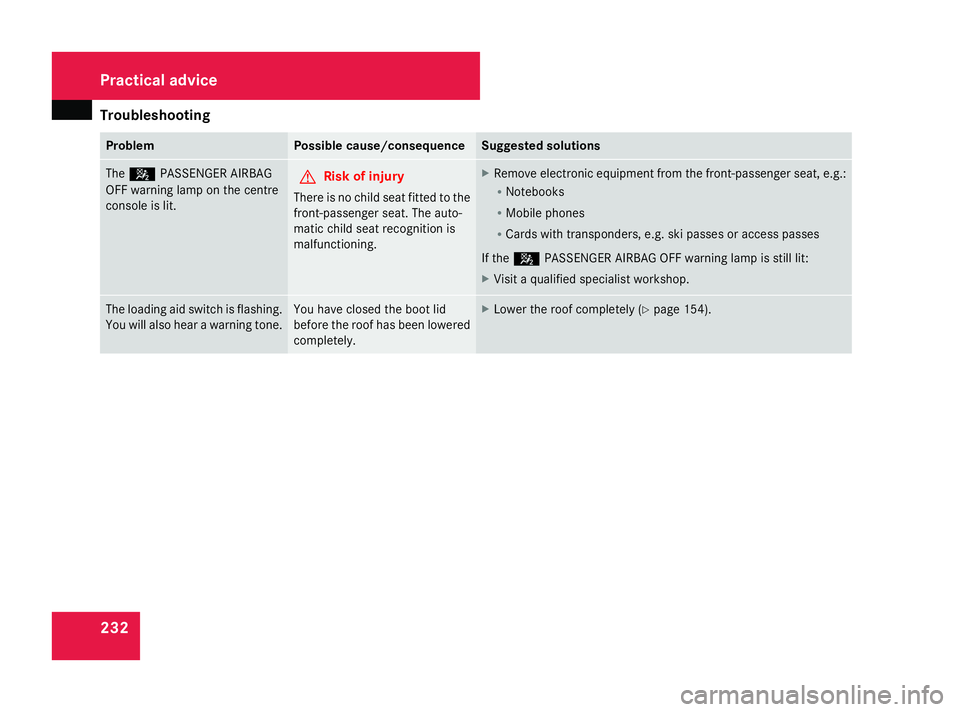
Troubleshooting
232 Problem Possible cause/consequence Suggeste
dsolutions The
5 PASSENGER AIRBAG
OFF warning lamp on the centre
consol eislit. G
Ris
kofi njury
There is no child seat fitted to the
front-passenge rseat. Th eauto-
matic child seat recognition is
malfunctioning. X
Remov eelectroni cequipment fromt he front-passenge rseat, e.g.:
R Notebooks
R Mobile phones
R Cards with transponders ,e.g.s ki passe soraccesspasses
If the 5 PASSENGER AIRBAG OFF warning lamp is still lit:
X Visi taq ualified specialis tworkshop. Th
eloadi ng ai dswitch is flashing.
Yo uw illa lsoh earaw arning tone. Yo
uh avec lose dthe boot lid
befor ethe roo fhas been lowered
completely. X
Lower the roo fcompletely (Y page 154). Practical advice
230_AKB; 5; 4, en-GB
bjanott,
Version: 2.9.6 2008-04-08T15:09:54+02:00-Seite 232 Dateiname: 6515_3089_02_buchblock.pdf; preflight